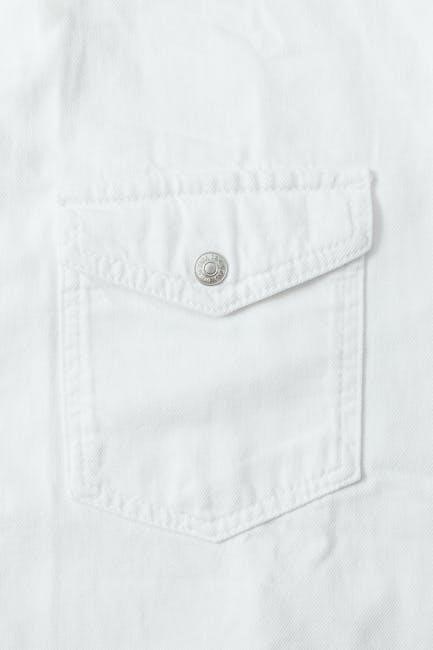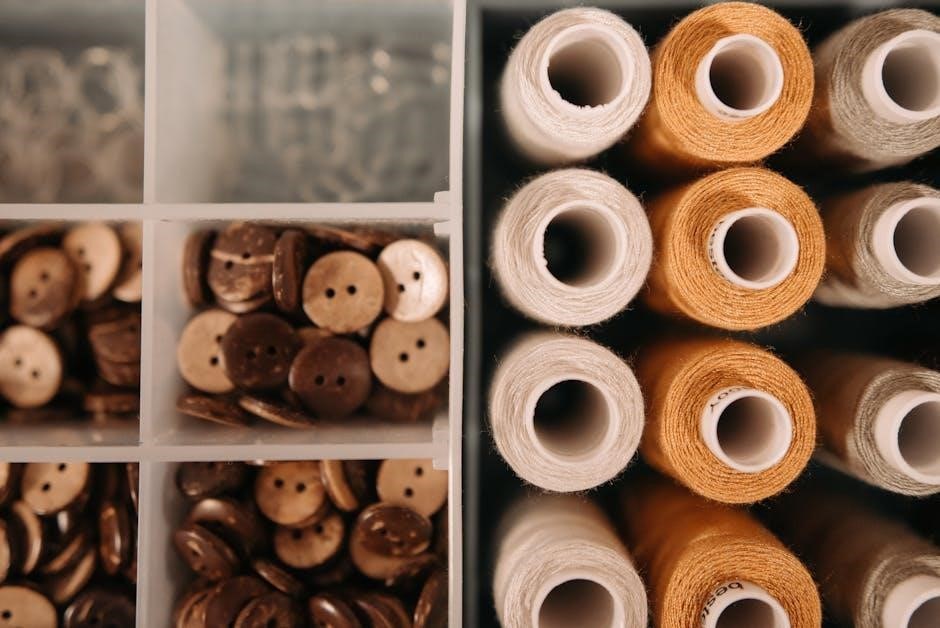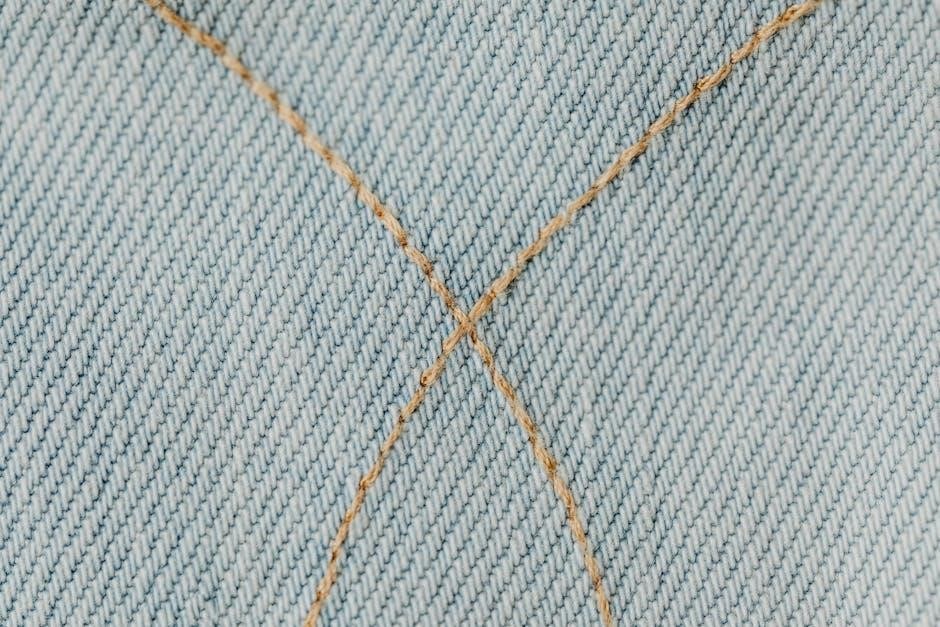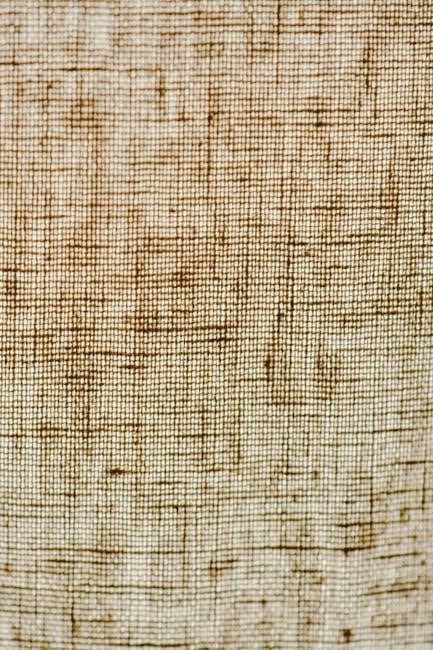
Tailoring is a versatile profession in WoW Classic, allowing players to craft cloth armor, bags, and other essential items. It’s a valuable skill for both functionality and gold-making, offering opportunities to create high-demand gear and supplies for casters. This guide provides a comprehensive overview of how to master Tailoring, covering everything from leveling strategies to farming cloth efficiently.
Overview of the Tailoring Profession
Tailoring is a primary profession in WoW Classic that allows players to craft cloth armor, bags, and other essential items. It is particularly useful for classes that rely on cloth armor, such as Mages, Priests, and Warlocks. Tailors can also create bags, which are highly sought after by players for inventory management. The profession does not have a dedicated gathering skill, so players must obtain cloth through mob drops, quests, or the auction house. Tailoring is often paired with Enchanting due to their complementary nature. This guide covers everything needed to master the profession, from leveling to crafting high-demand items.
Benefits of Tailoring in WoW Classic
Tailoring offers numerous benefits in WoW Classic, making it a valuable profession for players. It allows crafting of cloth armor, ideal for casters like Mages and Priests, and bags that boost inventory space—a necessity for any player. Tailors can craft high-demand items, providing a steady income through the auction house. Additionally, Tailoring pairs well with Enchanting, as crafted items can be enchanted for enhanced functionality. The ability to create gear and bags also supports alts and mains, making it a versatile profession for both solo players and guilds. This makes Tailoring a profitable and practical choice in WoW Classic.

Getting Started with Tailoring
Tailoring is a skill that allows players to craft cloth items, bags, and gear. To begin, find a Tailoring trainer in your faction’s major city and learn the profession. Gather necessary materials like cloth to start crafting. This profession is ideal for players seeking to create essential items for themselves or to sell on the auction house, making it a valuable skill in WoW Classic.
Finding Tailoring Trainers in Major Cities
Tailoring trainers are located in major cities of both the Alliance and Horde factions. For Alliance players, trainers can be found in Stormwind City, specifically in the Trade District near the auction house. Horde players can locate trainers in Orgrimmar, within the Valley of Honor, close to the city’s main gates. These trainers will teach you the Tailoring profession and provide essential recipes to start your crafting journey. Ensuring proximity to these trainers simplifies skill progression and resource management as you advance in the profession. Regular visits to these trainers are crucial for unlocking new recipes and improving your crafting abilities.
Alliance Trainer Locations
Alliance players can find Tailoring trainers in major Alliance cities. In Stormwind City, the trainer is located in the Trade District, near the auction house. Additional trainers can be found in Ironforge, Darnassus, and The Exodar. These locations provide easy access to the profession, allowing players to learn and upgrade their Tailoring skills. Stormwind is the most frequently visited due to its central role in Alliance activities. These trainers are essential for unlocking recipes and progressing through the Tailoring profession, making them a key resource for both new and experienced players.
Horde Trainer Locations
Horde players can learn Tailoring from trainers located in major Horde cities. In Orgrimmar, the trainer is in the Valley of Honor, near the auction house. Additional trainers can be found in Undercity, Thunder Bluff, and Silvermoon City. These locations are strategically placed to accommodate Horde players, making it easy to access the profession. Orgrimmar is particularly convenient for many players due to its role as a central hub. These trainers are vital for unlocking Tailoring recipes and advancing your skill level, ensuring you can craft essential items and gear for your character or to sell on the market.

Materials and Supplies for Tailoring
Tailoring requires various types of cloth, such as linen, wool, and silk, which can be obtained through farming, looting, or purchasing from vendors or the Auction House. Additional supplies like thread are essential for crafting. Players can also gather rare materials like Stranglekelp and Bruiseweed for specialized recipes. Efficiently sourcing these materials is crucial for leveling up and creating high-demand items like bags and caster gear. Proper inventory management ensures you always have the resources needed to craft effectively and maintain profitability in the game economy. Stockpiling materials early on saves time and gold in the long run, allowing for uninterrupted crafting sessions and quick responses to market demands. Crafting bags, for example, requires specific cloth types and thread, making it important to have a steady supply. Rare materials like Mooncloth can be challenging to obtain but are highly valuable for advanced recipes. Balancing material acquisition with crafting priorities ensures optimal progress in the Tailoring profession. Utilizing the Auction House wisely helps players procure rare or hard-to-farm materials without spending excessive time. Vendors often provide basic supplies, while more specialized items may require dedicated farming routes or strategic purchases. Organizing your crafting schedule around material availability maximizes efficiency and minimizes downtime. Tailors who master material management often find the profession more rewarding and lucrative, both in terms of skill progression and gold-making opportunities. Regularly restocking essential supplies prevents delays in crafting and ensures you can meet market demands without interruption. Exploring different sources for materials, such as dungeons, quests, or specific farming zones, broadens your supply chain and reduces reliance on a single method. This versatility is key to maintaining a steady flow of resources and staying competitive in the Tailoring market. By prioritizing material gathering and maintaining a well-stocked inventory, tailors can focus on crafting high-quality items and advancing their skills without unnecessary setbacks. Effective material management is a cornerstone of success in the Tailoring profession, enabling players to craft efficiently, earn gold, and support their characters’ progression. Tailors who invest time in organizing their supplies often find the profession more enjoyable and profitable, as they can adapt quickly to market trends and crafting needs. Building a reliable network for material acquisition ensures that you can craft consistently and meet the demands of both your character and the in-game market. This proactive approach to resource management is essential for mastering Tailoring and achieving long-term success in WoW Classic.
Types of Cloth and Their Uses
In WoW Classic, Tailoring relies on various types of cloth, each with unique uses. Linen Cloth is the most basic, used for low-level items like bandages and simple armor. Wool Cloth becomes available at higher levels, crafting mid-tier gear; Silk Cloth is rare and valuable, used for advanced armor and bags. Mageweave Cloth is sought after for high-level caster gear and specialized items. Mooncloth and Shadowcloth are rare and used for top-tier recipes, often requiring specific zones or dungeons to farm. Each cloth type plays a crucial role in crafting essential items, making them indispensable for tailors aiming to progress and create high-demand gear.

Farming Cloth Efficiently
Farming cloth efficiently is crucial for leveling Tailoring in WoW Classic. Focus on specific zones for each cloth type: linen in early zones like Westfall, wool in Hillsbrad, and silk in Stranglethorn. Optimize routes by circling mobs in high-density areas, ensuring minimal downtime. Use Herbalism for Stranglekelp and Bruiseweed, essential for advanced recipes. Prioritize humanoid mobs for cloth drops, as they yield more material. Efficient farming reduces time spent gathering resources, allowing you to focus on crafting and progressing your Tailoring skill. Proper planning and zone selection can significantly speed up your cloth accumulation, making the leveling process smoother and more efficient.
Purchasing Materials from the Auction House
Purchasing materials from the Auction House can save time and accelerate your Tailoring progression. Check prices regularly to buy cloth, threads, and other supplies at competitive rates. Buy in bulk to ensure a steady supply for crafting. Consider timing your purchases during off-peak hours when prices may be lower. Use addons like Auctioneer to track market trends and find the best deals. While farming is cost-effective, the Auction House offers convenience for players with gold to spend. This method is particularly useful for rare materials or when farming is impractical, allowing you to focus on crafting and leveling your Tailoring skill efficiently.

Leveling Tailoring from 1-300
Leveling Tailoring from 1-300 involves crafting items like cloth armor, bags, and other textiles. Use materials efficiently to progress through the skill levels and unlock advanced recipes.
Early Levels (1-100): Crafting Basic Items
Starting with Tailoring, focus on crafting basic items like bolts of linen cloth and simple tunics. These early recipes require minimal materials and provide steady skill progression. Use linen cloth, easily farmed from humanoids or purchased at the Auction House. Crafting bolts of linen cloth is especially efficient for skill gains. As you progress, unlock recipes for shirts, pants, and bags. These items are essential for both your character and other players, making them valuable for sale or personal use. Prioritize using inexpensive materials to minimize costs while leveling up to 100.
Mid Levels (100-200): Intermediate Crafting
At mid levels (100-200), tailors transition to crafting more complex items like dresses, robes, and bags. These recipes require higher-quality materials such as Silk Cloth and Mageweave Cloth, which can be farmed from higher-level mobs or purchased. Focus on crafting items like Black Mageweave Gloves and Runecloth Belt, which provide consistent skill gains. Bags remain a valuable craft, as inventory space is always in demand. Optimize your leveling by choosing recipes with the highest skill-up potential and minimizing material waste. This phase lays the foundation for advanced crafting, so ensure a steady supply of cloth to maintain progress.
Higher Levels (200-300): Advanced Recipes
Reaching higher levels (200-300) in Tailoring unlocks advanced recipes for high-end gear and specialty items. Crafting Mooncloth, Runecloth, and Felcloth becomes essential for creating powerful equipment like the Mooncloth Vest or Felcloth Gloves. These recipes often require rare materials and reagents, such as Moonwells for Mooncloth production. Focus on crafting high-demand items like Runecloth Bags, which are valuable for inventory management. To optimize leveling, prioritize recipes with high skill-up potential and ensure a steady supply of materials. This phase is crucial for mastering Tailoring and preparing for the endgame crafting scene.

Key Recipes for Tailors
Mastering essential recipes is crucial for tailors; Crafting bags, caster gear, and high-demand items ensures efficiency and profitability. Focus on Mooncloth, Runecloth, and Felcloth creations for optimal results.
Best Recipes for Leveling Up
Crafting bags like Small and Medium Bags early on provides consistent skill-ups and high demand on the Auction House. Bolts of linen and wool cloth are essential for mass production, ensuring efficient leveling. Mooncloth and Runecloth items, such as Mooncloth Robe and Runecloth Bag, become valuable as you progress. Crafting Felcloth gear later offers high demand for endgame content. Focusing on these recipes ensures steady progression and maximizes profitability, making your tailoring journey both efficient and rewarding in WoW Classic.
Crafting Bags and Their Importance
Crafting bags is a cornerstone of tailoring in WoW Classic, offering both utility and profitability. Bags provide essential inventory space for players, making them a consistently high-demand item. Crafting Small, Medium, and Large Bags early on ensures a steady income and helps other players manage their gear. As you progress, crafting higher-end bags like the Runecloth Bag becomes even more lucrative. This makes tailoring a valuable profession for both personal convenience and gold-making, as the need for extra storage is universal among players.
Creating Gear for Casters
Tailors play a crucial role in crafting gear tailored to casters, enhancing their magical prowess. Items like the Mooncloth Robe and Runecloth Pants are highly sought after for their spell power and mana efficiency, making them indispensable for mages, priests, and warlocks. High-level recipes allow tailors to create gear with specific stats, ensuring casters can perform optimally in both PvE and PvP. Crafting these items not only supports your own caster characters but also offers a lucrative market for selling to other players seeking to enhance their magical abilities. This makes tailoring a vital profession for caster-focused gameplay.

Farming Cloth and Resources
Farming cloth and resources is essential for tailors to craft items. Focus on gathering materials like Stranglekelp and Bruiseweed, which are vital for advanced recipes and creating high-demand goods efficiently.
Best Zones for Cloth Farming
The best zones for cloth farming in WoW Classic include Stranglethorn, the Hinterlands, and Tanaris. Stranglethorn is ideal for higher-level players, offering abundant cloth drops from jungle mobs. The Hinterlands is great for mid-level farming, with dense mobs dropping linen and wool. Tanaris is also a hotspot, especially for silk and mageweave. Farming in circles around these zones ensures optimal resource gathering. Use a mount for efficiency and focus on humanoid mobs, as they drop cloth more frequently. These zones provide the materials needed for crafting bags, gear, and other essential items, making them indispensable for tailors.
Optimizing Your Farming Routes
Optimizing your farming routes is crucial for efficient cloth gathering. Start by identifying the most densely populated areas with humanoid mobs, as they yield the most cloth. Use your mount to cover more ground quickly and plan circular or figure-eight patterns to minimize downtime. Focus on areas like Stranglethorn, the Hinterlands, and Tanaris, where cloth drops are abundant. Avoid unnecessary detours and keep your path tight to maximize resource collection. By refining your routes, you can gather materials faster, reducing time spent farming and increasing your tailoring progression. This strategy ensures you stay efficient and competitive in the Classic WoW economy.
Using Stranglekelp and Bruiseweed
Stranglekelp and Bruiseweed are essential herbs for tailors, used to craft Mooncloth, a key material for high-end gear and bags. Stranglekelp is commonly found in Stranglethorn Vale, while Bruiseweed grows in the Blasted Lands and Searing Gorge. Both herbs are renewable resources, making them ideal for farming. To maximize efficiency, focus on areas with high herb density and use a consistent farming route. These herbs are crucial for advanced tailoring recipes, ensuring a steady supply of materials for crafting Mooncloth and other valuable items. Regularly farming Stranglekelp and Bruiseweed will help you maintain a competitive edge in the Classic WoW economy.

Gold-Making Strategies with Tailoring
Tailoring offers lucrative gold-making opportunities by crafting in-demand items like bags and caster gear. Focus on producing high-quality bags, as they are always in short supply, and cater to casters needing specific stats. Selling these items on the Auction House can yield significant profits, especially during peak raiding hours when players seek upgrades. Consistent production and smart pricing will help you maximize your gold income through tailoring.
Selling Bags on the Auction House
Bags are a hot commodity in WoW Classic, as players constantly seek more inventory space. Crafting high-quality bags, particularly 16-slot and larger ones, can yield substantial gold. To maximize profits, monitor Auction House prices and undercut competitors slightly to ensure quick sales. Focus on crafting bags that align with current demand, especially during peak raiding hours when players have ample gold to spend. Consistent bag production and strategic pricing can make tailoring a gold-making powerhouse, ensuring a steady income stream in the competitive Classic WoW economy.
Crafting High-Demand Gear
Tailors in WoW Classic can craft high-demand gear, particularly for casters, including robes, hats, and belts. Mooncloth and Felcloth items are especially sought after for their stats and durability. Crafting these items requires rare materials like Mooncloth, which is only obtainable from Moonwells in Ashenvale. Gear tailored for healers and mages often sells well, as these classes rely heavily on cloth armor. By focusing on high-demand recipes and timing your Auction House listings during peak raiding hours, tailors can capitalize on the constant need for upgraded gear, making this a lucrative aspect of the profession.
Setting Up a Profitable Tailoring Business
To establish a profitable tailoring business in WoW Classic, focus on understanding market trends and supply and demand. Specialize in crafting high-demand items like bags, caster gear, and rare materials such as Mooncloth. Farm cloth efficiently or purchase in bulk from the Auction House to minimize costs. Set competitive prices for your products, ensuring a balance between profitability and attractiveness to buyers. Timing your Auction House listings during peak hours, such as weekends or raid times, can maximize sales. Reinvest profits into expanding your recipe collection or materials to sustain long-term growth and stay ahead of competitors in the market.

Pairing Tailoring with Other Professions
Combining Tailoring with complementary professions like Enchanting or Leatherworking enhances efficiency and profitability. These synergies allow crafting complete gear sets or optimizing resource usage for maximum benefit.
Best Professions to Combine with Tailoring
Pairing Tailoring with Enchanting or Leatherworking can significantly enhance your crafting efficiency. Enchanting allows you to imbue your tailored gear with powerful stats, increasing its value and usability. Leatherworking complements Tailoring by enabling the creation of leather goods, which can be used alongside cloth items for a versatile arsenal. Both combinations ensure resource optimization and open up more crafting opportunities, making you self-sufficient and competitive in the WoW Classic economy. These synergies are particularly beneficial for players aiming to craft high-demand items for personal use or profit.
Enchanting and Tailoring Synergy
Combining Tailoring with Enchanting creates a powerful synergy, allowing players to craft and enhance their own gear. Enchanting enables the addition of magical properties to tailored items, increasing their value and effectiveness. This pairing is particularly beneficial for creating high-demand caster gear, as enchants can significantly boost spellpower or intellect. Additionally, disenchanting unwanted items provides a steady supply of materials for both professions, reducing reliance on the auction house. This dual-profession setup not only enhances your character’s performance but also increases your profitability, making it a highly efficient combination for players aiming to excel in both crafting and gameplay.
Leatherworking and Tailoring
While Tailoring focuses on cloth-based items, Leatherworking deals with leather and mail gear, making them complementary professions. Both rely on similar resource-gathering methods but cater to different armor types. Players can benefit from pairing these professions to craft a wide variety of gear, covering both cloth and leather needs. However, managing both requires significant inventory space and material investment. This combination is ideal for characters with multiple specs or for players aiming to supply a wide range of in-game demands, maximizing their crafting versatility and market reach. It allows for a balanced approach to gear creation and resource utilization.
Mastering Tailoring in WoW Classic requires dedication, efficient cloth farming, and crafting valuable items. Stay competitive by adapting to market demands and continuously improving your skills.
Final Tips for Mastering Tailoring
To excel in Tailoring, stay organized by keeping ample storage space for materials and crafted items. Regularly check the Auction House to adapt to market demands, ensuring profitability. Focus on crafting high-demand items like bags and caster gear, as they consistently sell well. Use Stranglekelp or Bruiseweed for efficient cloth farming. Experiment with advanced recipes to diversify your offerings. Maintain a steady supply of materials to avoid delays in crafting. Consistently practice and refine your techniques to maximize efficiency. By staying proactive and resourceful, you’ll master Tailoring and dominate the WoW Classic economy.

Staying Competitive in the Market
In WoW Classic, staying competitive in the Tailoring market requires adaptability and attention to demand trends. Regularly monitor the Auction House to identify gaps and capitalize on undersupplied items. Focus on crafting high-quality bags and caster gear, which are consistently in demand. Optimize your crafting schedule to minimize material waste and maximize profit margins. Build a reputation for reliability and quality to attract repeat customers. Stay ahead by experimenting with new recipes and farming techniques; By staying informed and proactive, you can maintain a strong presence in the competitive Tailoring market and secure consistent gold earnings.
Leave a Reply
You must be logged in to post a comment.